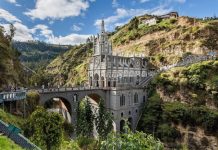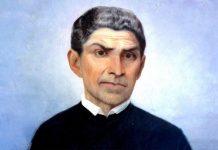Chillicothe, Missouri, USA (Tuesday, 09-04-2018, Gaudium Press) The Church of St. Columban in Chillicothe, Missouri, has been restored to the same splendor it had when built in the 19th century. This remarkable restoration was done by a firm dedicated to sacred art: Conrad Schmitt Studios in conjunction with the Liturgical Arts Journal of the United States.
The Church of St Columban after restoration. Photo: Liturgical
Arts Journal
St. Columban Catholic Church is one of the oldest and most historic parishes in the Diocese of Kansas City-St. Joseph. Founded in 1857 by Fr. John Hogan, it soon became the hub from which many of the other surrounding parishes in north and north-central Missouri were later established.
The current church was consecrated on November 23rd, 1879. By 1900, the church was expanded to contain its transepts and apse. By 1913 side altars and murals were added.
Once completed St. Columban’s was considered one of the largest and most beautiful churches in northern Missouri.
Restoring a vision
Over the decades the parish interior has undergone many changes in design. While still overall beautiful by comparison, the design of the church did not live up to the potential the building was originally meant to have. The state of the interior had further been confounded by years’ worth of water damage to the ceiling and walls. In 2014, the parish completed a replacement of the roof which had been a primary contributor to the problems inside. Though this important step was taken, the effects of the damage already done were still evident in the cracked paint and damaged plaster walls which were prevalent throughout the church.
Above: the church in the XIX century. Below: After
first restoration in the XX century.
Photo: Liturgical
Arts Journal
This vision recorded by St. John the Apostle is symbolic of the Church on earth, which is the new Jerusalem. This passage from scripture raises our minds to consider that just as the earthly Jerusalem held the Temple and God’s presence within, so our churches also contain God’s Eucharistic presence in the tabernacle. They are meant to be a little piece of heaven come down to earth.
Thus, our church’s architect, Br. Adrian Wewer, incorporated both new and old elements of gothic architecture into its interior. Its pointed arches and high ceilings intentionally are meant to draw the eyes upward to contemplate heavenly realities. The many images of the saints present in the church remind us to follow the example of these holy ones and ask their prayers for us so that we too may one day be in heaven with God and them.
With an appreciation in mind for the lofty ideal the church interior is meant to inspire, efforts have been made to restore some of the beauty and sacredness that has been lost over the decades. The new design scheme proposed and adopted was heavily informed by the church’s interior design at its height in 1913 while still incorporating some new elements. As such, it paid fitting tribute to the vision of Br. Adrian and our ancestors whose hands piously raised this parish church to be a radiant testimony on earth to the splendor of God above.
Numerous repairs to the current state of the walls and ceiling were among the first steps taken. In an effort to help prevent any future damage from the exterior, present an ideal surface to work on, and add longevity to the decorative work fiberglass polymer was added to the interior surface of the walls and ceiling after repairs were made and before paint was applied. The design scheme used a pallet of neutral colors on the walls and ceiling in order to let the natural lines and architecture of the building become prominent to the eye. Historically-informed stencils of gold, green and red highlighted many of the arches and corners culminating in floral motifs. Two murals painted in 1913 by Theodore Brash were cleaned and restored to their former beauty. The many tall columns of the church typical of Gothic architecture were painted to resemble marble. Once again the historic altar rail was re-positioned to a place of use at the opening of the sanctuary demarcating this Holy of Holies and accommodating those who wish to receive Holy Communion while kneeling in reverence.
Source St Columban Catholic Church






























